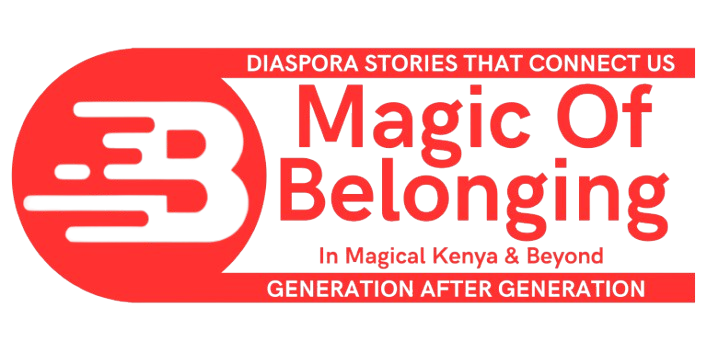In Nairobi’s fast-paced digital world, where influencers bloom overnight and trends burn out by morning, Joy Kendi has carved a lane that feels less like a social media sprint and more like a quiet, deliberate revolution. You’ll know her by the striking buzz cut, the camera angles that play like film stills, and the fierce vulnerability with which she shares both curated beauty and life’s invisible bruises.
But her story didn’t begin with viral posts or brand deals—it started in childhood sketches of dresses and a family dream of building a life back home.
Born in Kenya in 1988, Joy spent six formative years in the United States before returning home in 2009. She carried back with her a degree in psychology from USIU and a deepening sense of identity. Nairobi was changing, and so was she. In a city crackling with creative energy but still learning how to monetize it, Joy found herself at a crossroads—caught between the limitations of the local fashion scene and the dreams she had once mapped out in childhood.
She tried styling. That lasted six months. “I hated it,” she recalls. “It wasn’t what I thought it would be.” What followed wasn’t a master plan, but a stumble into possibility. When she saw fellow Kenyan blogger Nancie Mwai travel to Germany through a blogging opportunity, something clicked. “That’s when my whole mindset shifted,” Joy remembers. “I stopped seeing content as just an outlet. I started seeing it as a business.”
The University of YouTube and the Business of Becoming
With no formal training in media, production, or fashion, Joy became a student of the internet—“The University of YouTube,” she jokes. She taught herself everything: photography, lighting, editing, and brand negotiation. In a city with few mentors and fewer reliable photographers, she became a team of one. Her first investment as a content creator wasn’t makeup or wardrobe—it was a DSLR camera and studio lights.
What grew out of this self-taught hustle wasn’t just a blog or an Instagram feed. It was a business. But even more than that—it was a deeply Kenyan brand. Not in the kitschy, tourist-trap way that reduces culture to colors and crafts, but in the unflinching way she portrayed Nairobi life: stylish, yes—but also grounded, accessible, real.
“I realized fashion blogging was limiting,” she says. “People here want lifestyle. They want to know where to eat, where to travel, how to feel beautiful. I had to broaden what I shared—and I had to keep it honest.”
I realized fashion blogging was limiting,” she says. “People here want lifestyle. They want to know where to eat, where to travel, how to feel beautiful.
This honesty became her signature. Whether reviewing a lipstick, styling an outfit, or discussing her favorite cafes, Joy’s tone was never just promotional—it was personal.
Buzz Cuts, ELLE Spreads, and the Power of Kenyan Skin
In a world of glossy wigs and filtered faces, Joy made a startling decision: she shaved her head. At the time, it felt like a personal reset. “Going bald was my way of showing the world I had changed,” she said. But the ripple effect went far beyond hair. The look challenged beauty norms still deeply entrenched in Kenyan and global culture—celebrating dark skin, bold features, and unapologetic presence.
It didn’t take long for the world to notice.
In 2018, Joy landed a major campaign with Indian leather brand Hidesign, which led to a two-page spread in ELLE Magazine. The brand founder was candid—he’d chosen her because of how striking her dark skin looked against the leather. It was a rare moment where authenticity didn’t have to bend itself into Western molds. Her Kenyan identity was not just accepted—it was the selling point.
The Nairobi Hustle: Where Business Meets Belonging
But Joy’s rise wasn’t all editorial spreads and brand launches. Nairobi’s influencer ecosystem was still developing—and often deeply flawed. Agencies sometimes diverted funds meant for creators. Campaigns were inconsistent. And professional standards were blurry.
“You had to become your own manager, editor, accountant, everything,” she reflects. “There were no playbooks, no unions. You had to learn by being burned.”
So she did. Joy built her brand on values that now shape the advice she gives younger creators: Know your worth. Learn your craft. Understand contracts. Be willing to say no.
She kept a list of brands she wanted to work with and turned down others—even when the money was tempting. For her, sustainability meant alignment—not just financially, but emotionally and ethically.
As blogging faded and video content took over, Joy pivoted once more, investing in YouTube. “People don’t read like they used to,” she observed. “They want to see you move, hear you laugh, get a fuller sense of who you are.” This shift allowed her to show more dimensions of herself—culinary experiments, travel diaries, mental health struggles—and build a community, not just an audience.
Breaking the Silence: Mental Health and the Power of Public Healing
In 2025, Joy shared something she had kept hidden: she had spent 45 days in her house, paralyzed by depression.
“It wasn’t just burnout,” she said. “It was a fog. A weight. I thought that naming it would fix it in a week—but it took me seven months to come back.”
In a country where mental health is still cloaked in stigma, especially for women in the public eye, her openness was seismic. She didn’t present a neat recovery narrative. She admitted the
mess. The therapy. The work. And in doing so, she gave others permission to acknowledge their own pain.
“Your 20s are not for chilling,” she once said in a now-famous quote. “Work yourself to the core now, so you can relax later.” But what she added later was just as important: “Rest is part of the work too.”
A Kenyan Blueprint for Global Impact
In 2020, Joy launched her own fashion label Itikadi—a Swahili word that means “belief” or “ideology.” It was a natural extension of her philosophy: that fashion should reflect culture, confidence, and individuality.
“People ask if I want to move,” she says. “But I’ve built something here. Kenya gave me the stories. I just told them well.”
Today, with 400,000 Instagram followers, a growing YouTube presence, and a roster of high-impact campaigns under her belt, Joy Kendi is more than an influencer—she’s a blueprint for the next generation of African digital entrepreneurs.
Her work has inspired not just how Kenyans see themselves on screen—but how the world sees Kenya: stylish, sharp, layered, modern.
Home as Anchor, Not Limitation
Joy never needed to leave Nairobi to succeed. She made Nairobi the reason she succeeded.
The city’s chaos taught her adaptability. Its culture gave her a voice. Its gaps forced her to become multi-skilled. And its people—her audience—pushed her to keep growing.
“People ask if I want to move,” she says. “But I’ve built something here. Kenya gave me the stories. I just told them well.”
She’s set her sights on Vogue next. And why not? If there’s one thing Joy Kendi’s journey has shown us, it’s that global doesn’t mean abandoning local—it means amplifying it, with style, strategy, and soul.
The Review
Apple iPhone 9
A wonderful serenity has taken possession of my entire soul, like these sweet mornings of spring which I enjoy with my whole heart. I am alone, and feel the charm of existence in this spot, which was created for the bliss of souls like mine.
PROS
- Good low light camera
- Water resistant
- Double the internal capacity
CONS
- Lacks clear upgrades
- Same design used for last three phones
- Battery life unimpressive





























